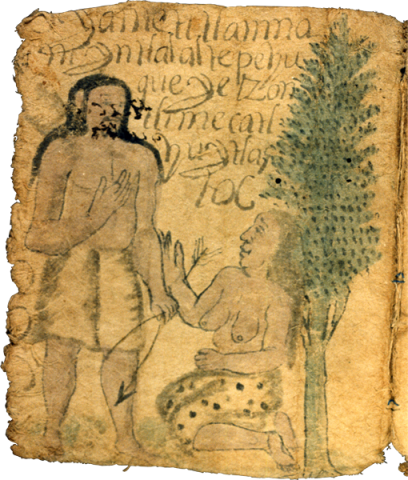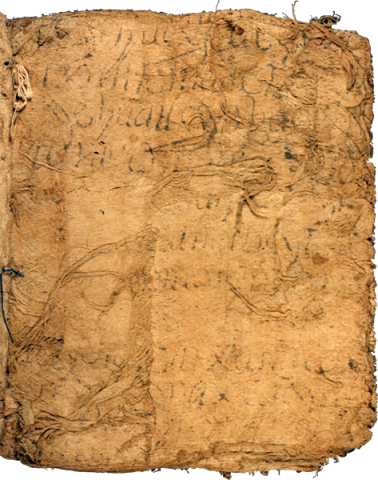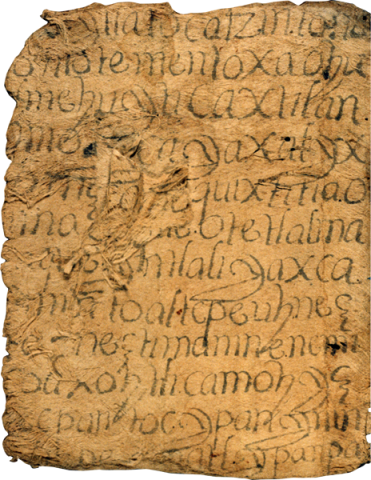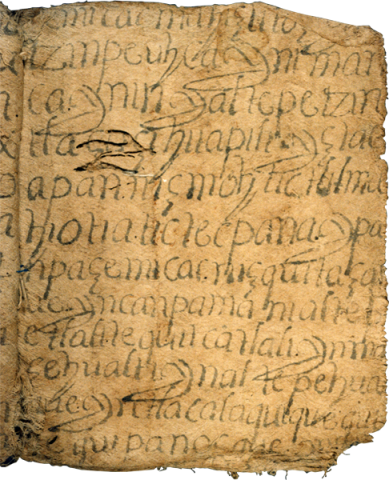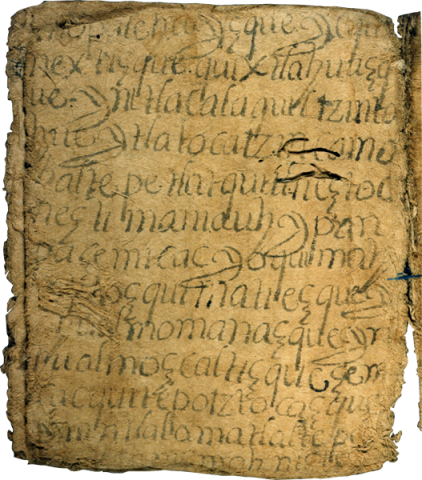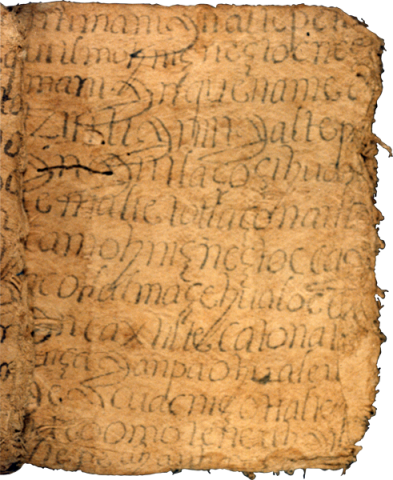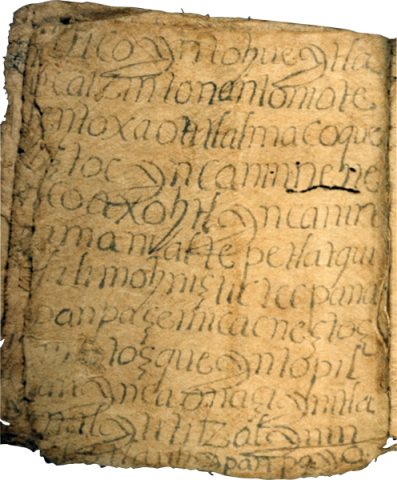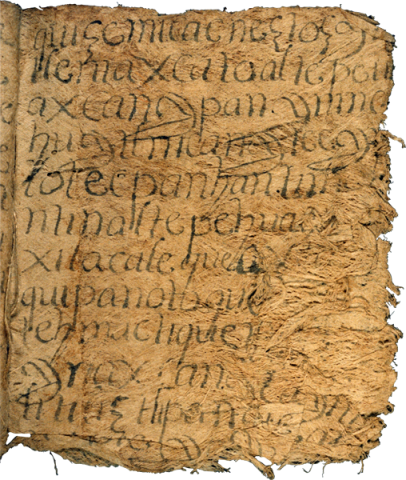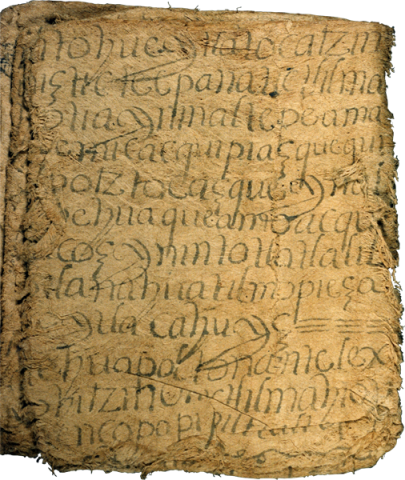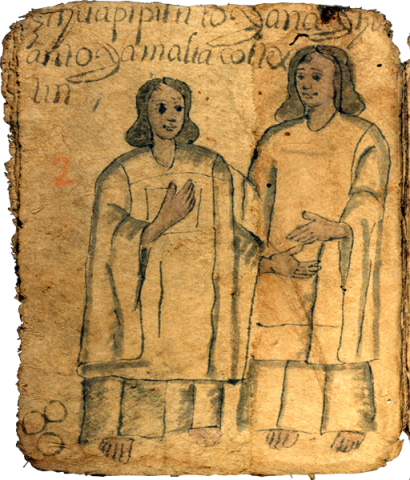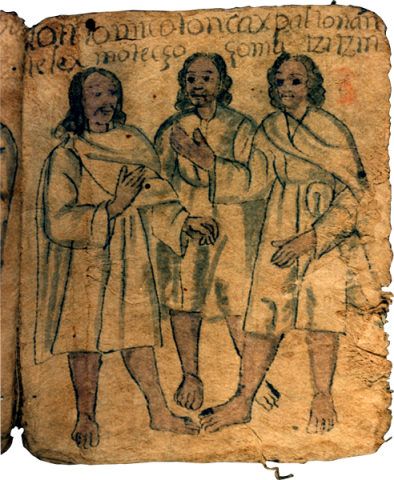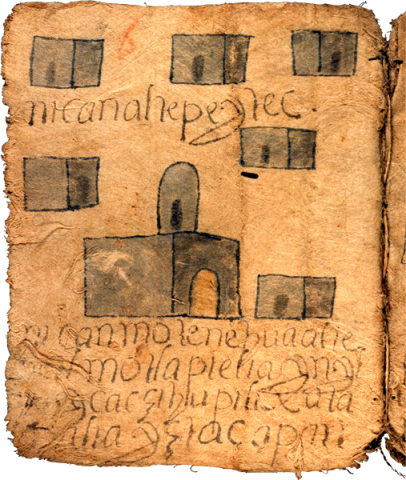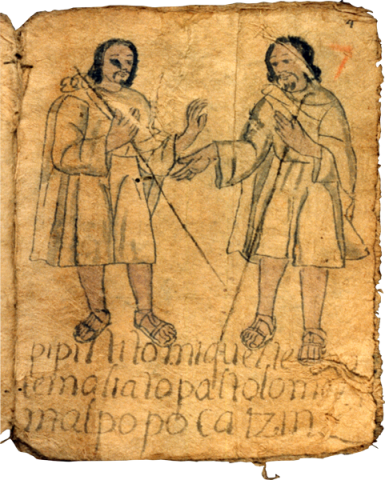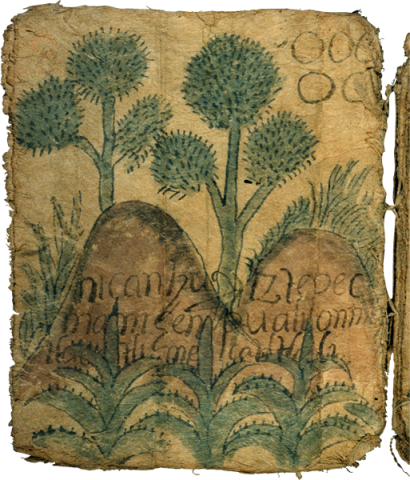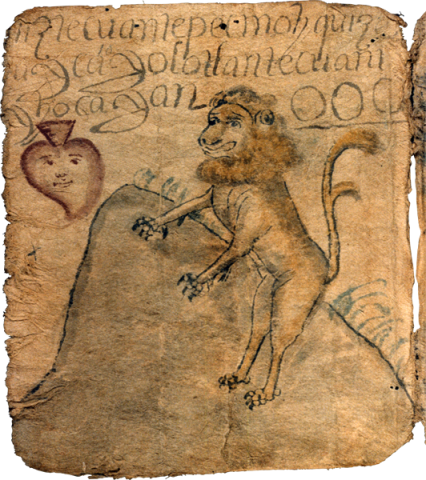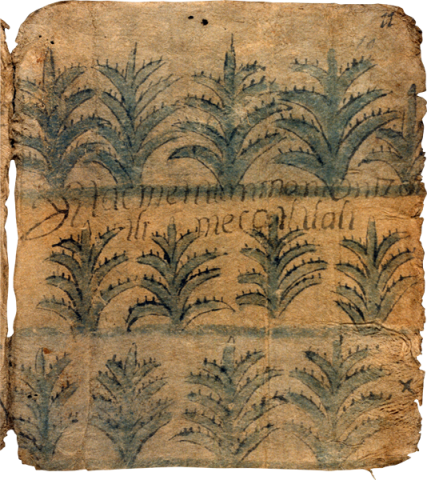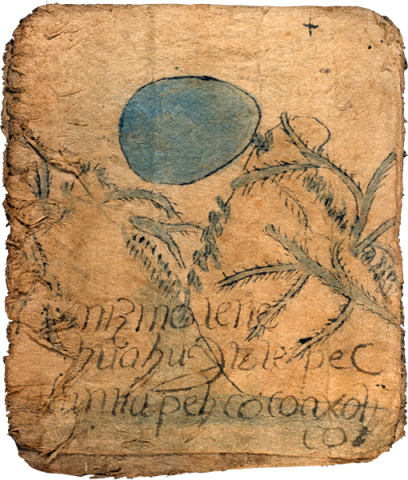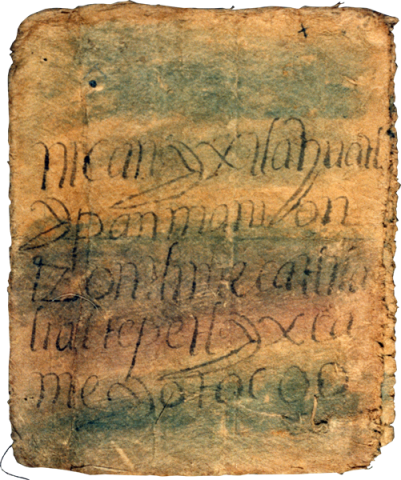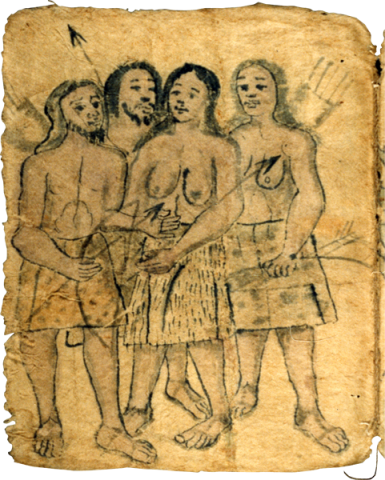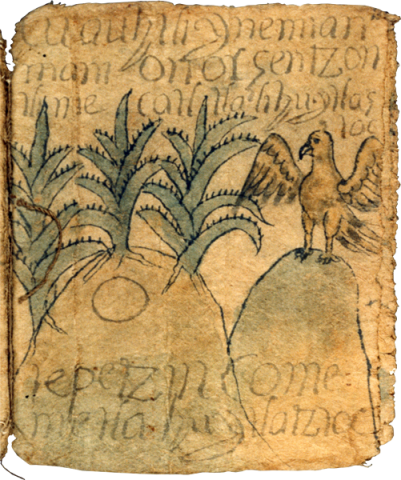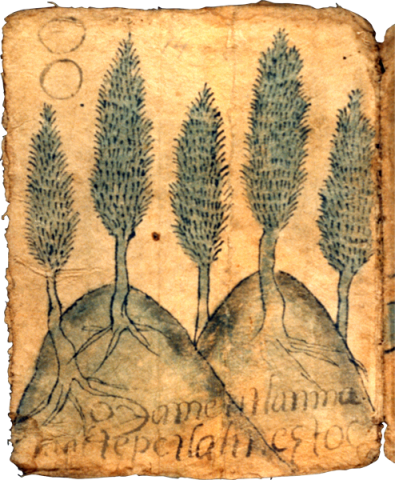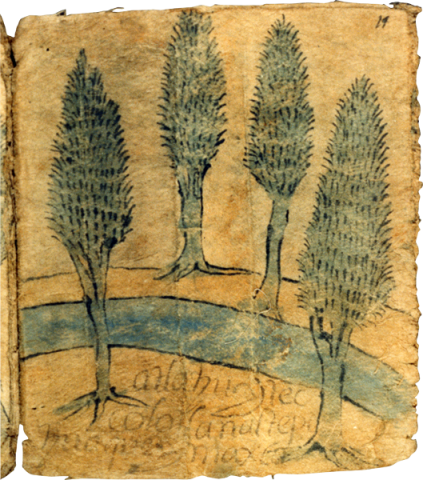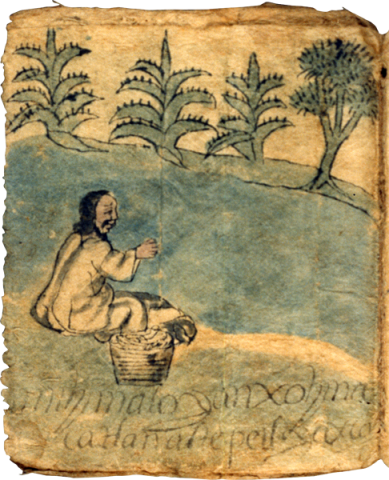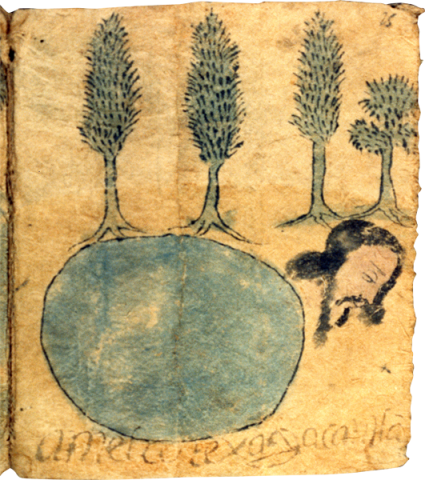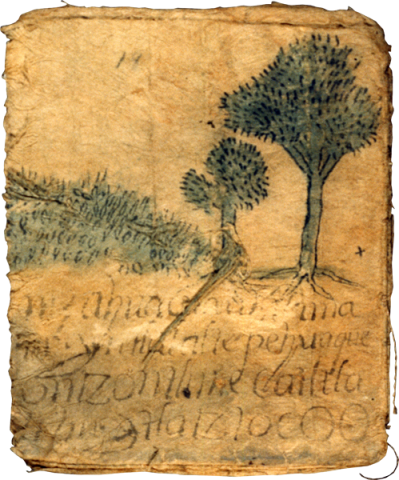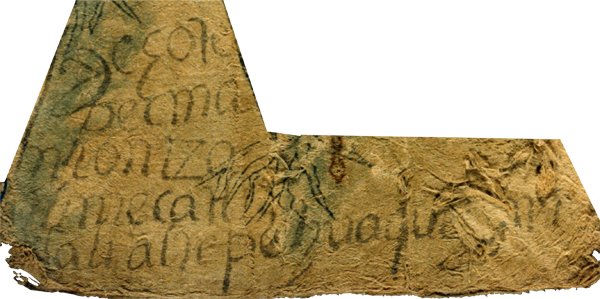 |
[IV, f. 1r.] ycçotepec mani ontzotli mecatl ...lali altepehuaque ym.... |
[IV, f. 1r.] At Icçotepec are two tzontli [presumably, 2 x 400, or 800] mecatl [mecates, in Spanish] of land that are the property of the citizens of the altepetl. |
[IV, f. 1r.]
ycçote
pecma
niontzo
tlimecatl
.lalialtepehuaqueym. |
[IV, f. 1r.] En Yetzontepec hay dos tzontli (2 x 400, o 800) mecatl (varas?) de tierra que pertenecen a los ciudadanos del pueblo. |
[IV, f. 1r.] Icçotepec. Mani ontzontli mecatl tlalli. Altepehuaque imaxca. |
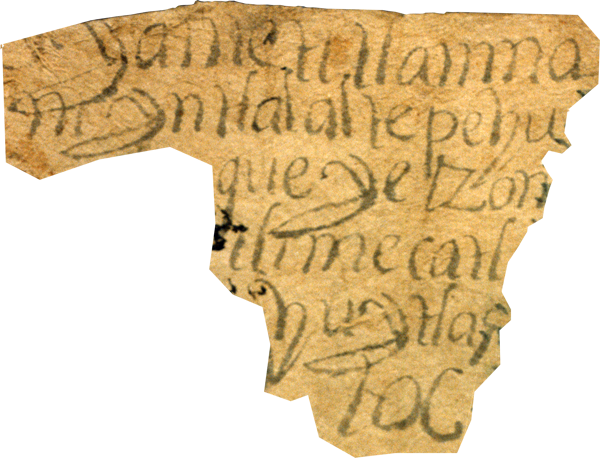 |
[IV, f. 1v.] ....yametitlan mani yntlal altepehu..que yetzontli mecatl huytlaztoc |
[IV, f. 1v.] [Co]yametitlan. It is the land of the citizens of the altepetl. It is three tzontli [presumably, 3 x 400, or 1,200] mecatl [mecates, in Spanish] long. |
[IV, f. 1v.]
yametitlanma
ni yntlalaltepehu
queyetzon
tlimecatl
huytlas
toc |
[IV, f. 1v.] Yametitlan (Entre los Jabalíes). Es la tierra de los ciudadanos del pueblo. Extiende (o mide) tres tzontli (3 x 400, o 1,200) mecatl (varas?). |
[IV, f. 1v.] [Co]yametitlan. Mani intlal altepehuaque. Yetzontli mecatl huitlatztoc. |
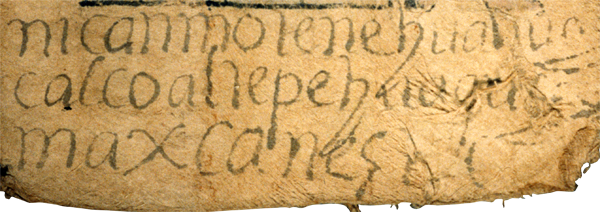 |
[IV, f. 2r.] nican motenehua hueycalco altepehuaque ymaxca nest...c |
[IV, f. 2r.] Here at the place called Hueicalco the property of the citizens of the altepetl appears [is shown in the pictorial]. |
[IV, f. 2r.]
nicanmotenehuahuey
calcoaltepehuaquey
mazca nest..c |
[IV, f. 2r.] Aquí en el paraje llamado Huelcalco las propiedades de los ciudadanos del altepetl aparecen [mostradas en la imágen]. |
[IV, f. 2r.] Nican motenehua Hueicalco altepehuaque imaxca neztoc. |
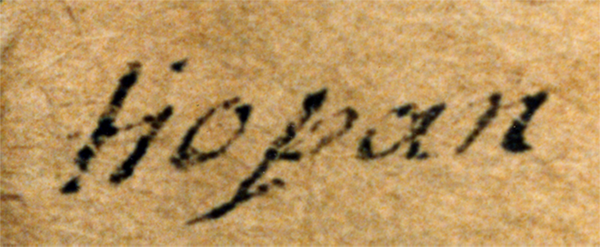 |
tiopan |
Church |
tiopan |
Iglesia |
Teopan |
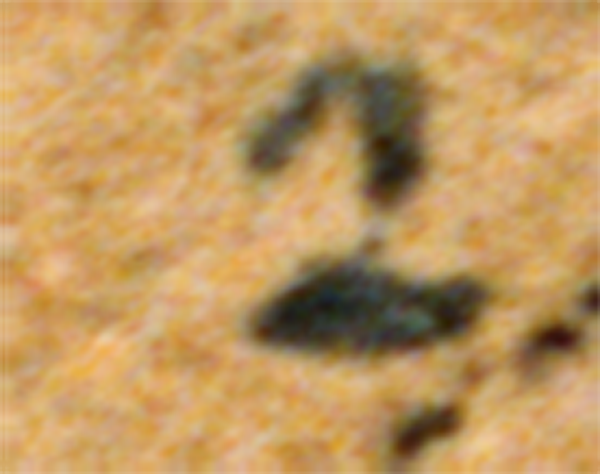 |
2 |
2 |
2 |
2 |
2 |
 |
tlacal |
person |
tlacal |
persona |
tlacatl |
 |
quilia |
(?) |
quilia |
(?) |
quilia |
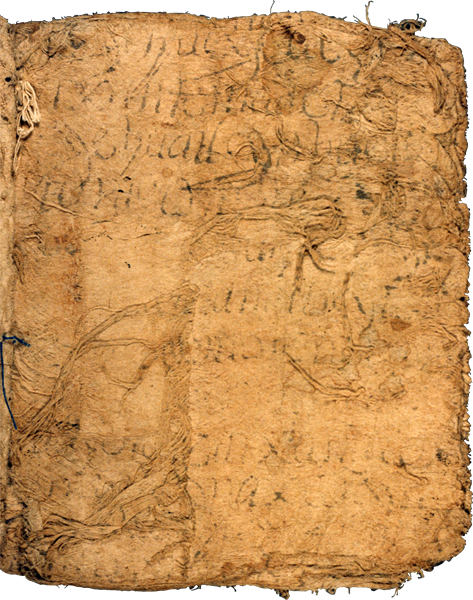 |
[IV, f. 3r.] ....huey............x.....to...............yehuatl yn t.......ton....................................
|
[IV, f. 3r.] ..... the great ..... (someone) ... don(?) ...................... |
[IV, f. 3r.]
....huey..........
..x.....to...........
....yehuatl ynt.....
..ton..............
......................
......................
......................
......................
......................
......................
...................... |
[IV, f. 3r.] .... el gran .... (alguien) .... don(?) .................... |
[IV, f. 3r.] ....huei............x.....to...............yehuatl in t.......ton.................................... |
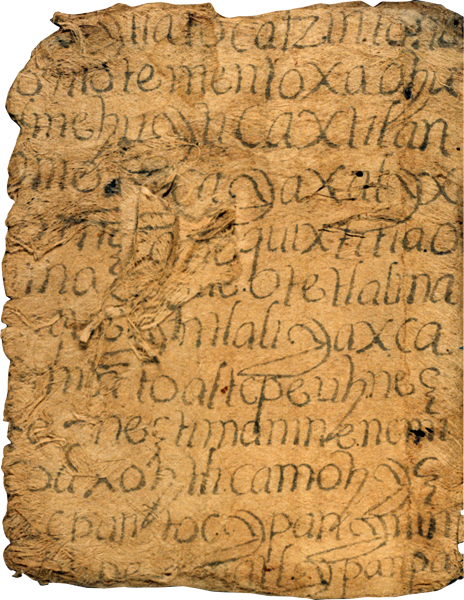 |
[IV, f. 3v.] ...ytlatocatzin ton a[nt]onio te mentoxa ohu[al]mehuyti caxtilan omo....caya xalyx o niz ....quixtitla omo.......otetlalma....que yn tlali yaxca..m....toaltepeuh nez.... neztimani nenemi
coaxochtli ca moch yz..cpantoc ypan ynin.....pe....matl ypanpa
|
[IV, f. 3v.] Our great ruler don Antonio de Mendoza came from Castile .............. They won land for people, land that belongs to our altepetl. It appears, it appears [how] the boundaries run, so that all .... on it, this altepetl paper, for this reason |
[IV, f. 3v.]
...ytlatocatzintona
oniotementoxaohu
..mehuyticaxtilan
omo...cayaxal(or t?)yx
oniz........quixtitiao
mo.......otetlalma
...queyntlaliyaxca
..m....toaltepeuh nez
..o...neztimaninenemi
coaxohtlicamohyz
..cpan tocypanynin
.....pe....matlypanpa |
[IV, f. 3v.] Nuestro gran gobernante, don Antonio de Mendoza, llegó de Castilla ........ Ganaron tierras para la gente, tierras que pertenecen a nuestro pueblo. Parece, parece [como] los linderos corren, para que todo .... en este documento del pueblo, por esta razón |
[IV, f. 3v.] [Tohue?]itlatocatzin don Antonio de Mendoza ohualmehuiti Caxtilan omo...caya xalyx..o niz ...... quixtitla omo.... otetlalmaçeuhque yn tlalli iaxca ....m....toaltepeuh neztoc neztimani nenemi quaxochtli ca moch iz...cpantoc ipan inin altepeamatl ipampa |
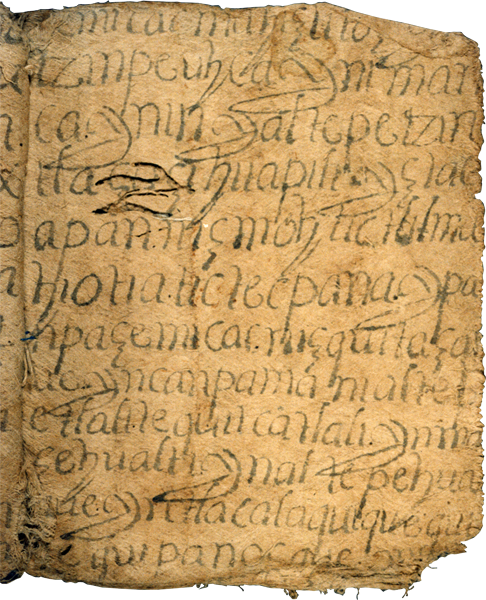 |
[IV, f. 4r.] ...emicac mahiztitoz y...tzinpeuhca yn imanca ynin yaltepetzin tlaçocihuapili yztacapan niz moh tictlilmahiotia tictecpana ypanpa cemicac niz quitazque yn canpa mani altepetlali tequitcatlali yn macehualti yn altepehua[q]ue yn tlacalaquique qui[t?]equipanozque .... |
[IV, f. 4r.] Eternally [everything] will be known about the foundation [and location?] this altepetl of the precious lady at Iztacapan. Here we write everything, we put it in order, so that eternally here the citizens of the altepetl, who are the tribute payers, will see where are the lands of the altepetl, the tribute lands of the commoners, of the citizens of the altepetl, of the tribute payers. They are to work them [or serve the saint]. |
[IV, f. 4r.]
..emicac mahiztitoz y...
tzinpeuhca yni man
ca ynin yaltepetzin
tlaçoçihuapiliyztac
apannizmohtictlilma
hiotiatictecpanaypa
npacemicacnizquitazq
ueyncanpamanialtep
etlalitequitcatlali yn ma
çehualti ynaltepehua
..ueyntlacalaquiquequi(?)
..equipanozque ..... |
[IV, f. 4r. ] Eternamente [todo] sera conocido acerca de la fundación [y localización] este pueblo de la preciosa dama en Iztacapan. Aquí escribimos todo ,lo ponemos en orden, para que eternamente los ciudadanos del pueblo, quienes pagan los tributos, pueden ver donde están las tierras del pueblo, las tierras tributarias de los macehuales, de los ciudadanos del pueblo, de los pagadores de tributos. Ellos deben trabajar para ellos [o servir a su santo]. |
[IV, f. 4r.] cemicac machiztitoz i...tzinpeuhca in imanca inin ialtepetzin tlaçoçihuapilli Iztacapan niz moch tictlilmachiotia tictecpana ypanpa cemicac niz quitazque in campa mani altepetlali tequitcatlalli in maçehualti in altepehuaque in tlacalaquique quitequipanozque .... |

